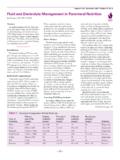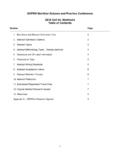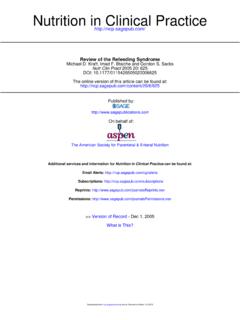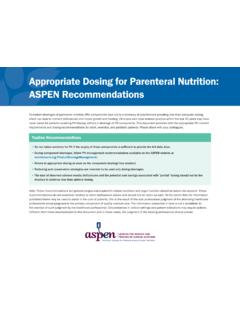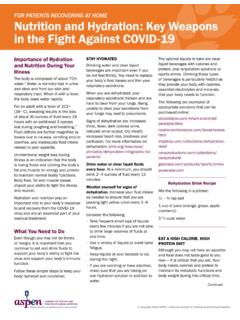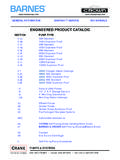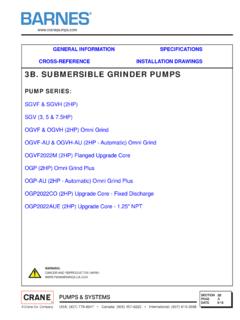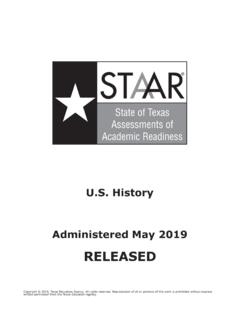Transcription of Nutrition Therapy in the Patient with COVID-19 Disease ...
1 Nutrition Therapy in the Patient with COVID-19 Disease Requiring ICU Care Updated May 26, 2020. Robert Martindale, PhD, MD Professor of Surgery, Department of Surgery, Oregon Health and Science University, Portland Oregon Jayshil J. Patel MD Associate Professor of Medicine, Division of Pulmonary & Critical Care Medicine, Medical College of Wisconsin, Milwaukee, Wisconsin Beth Taylor DCN, RD-AP- Research Scientist/ Nutrition Support Dietitian, Barnes-Jewish Hospital, St. Louis, Missouri Malissa Warren, RD - Advanced Practice Nutrition Support Dietitian, Oregon Health and Science University and Portland VA Health Care Center, Portland Oregon Stephen A McClave MD - Professor of Medicine, Division of Gastroenterology Hepatology and Nutrition , University of Louisville, School of Medicine, Louisville Kentucky Reviewed and Approved by the American Society for Parenteral and Enteral Nutrition Intensive care units (ICU) worldwide have become overwhelmed with the severe acute respiratory syndrome coronavirus 2 (SARS-CoV-2) induced respiratory failure leading to COVID-19 Disease .
2 Good supportive care remains the cornerstone in managing critically ill patients with COVID-19 . The need to address the provision of critical care Nutrition remains an integral component of these supportive measures. The nutritional management of the ICU. Patient with COVID-19 is in principle very similar to any other ICU Patient admitted with pulmonary compromise. Given the lack of direct evidence on patients with COVID-19 , especially those with shock, many of these recommendations are based on indirect evidence from critically ill patients in general and those with sepsis and ARDS. The 2016 SCCM/ASPEN Guidelines for Provision and Assessment of Nutrition Support Therapy in the Adult Critically Ill Patient are slightly outdated because the literature search supporting them ended in December ,2 ESPEN also has critical care Nutrition guidelines3. and just produced a new paper that does address COVID-19 (not yet published). This brief review will address timing, route, and monitoring of nutritional Therapy based on best available evidence, but also provide guidance on management specific to COVID-19 Disease , while taking into consideration key guiding principles related to this Disease process.
3 Guiding Principles for SARS-CoV2 Management Like all interventions related to the care of the Patient with COVID-19 , the delivery of Nutrition in critically ill patients should take into consideration the following principles: 1. Cluster care, meaning all attempts are made to bundle care to limit exposure. 2. Adhere to Centers for Disease Control (CDC) recommendations to minimize aerosol/droplet exposure with an emphasis on hand hygiene and utilization of personal protective equipment (PPE) to protect healthcare providers and limit spread of Disease . 1. Nutrition Therapy in the Patient with COVID-19 Disease Requiring ICU Care: Updated March 30, 2020. 3. Preserve use of personal protective equipment (PPE), which is becoming a depleted resource in various regions of the United States, by limiting the number of staff providing care and optimizing other PPE preserving strategies. Recommendation 1: Nutrition Assessment We recommend all healthcare providers, including dietitians, nurses, and other healthcare professionals involved in the Nutrition assessment should follow PPE standards set forth by the CDC for all patients with COVID-19 Disease and adhere to their institutional recommendations.
4 PPE includes protective eyewear, isolation gown, a face shield, and an N95 respirator ( ). Pragmatically, with limited PPE supply, many dietitians are not entering ICUs or Patient rooms of patients in isolation and not performing a Nutrition focused physical examination but rather relying on other providers to collect physical data on those patients. Dietitians are using other means to collect assessment data including calling the Patient or family, and using telehealth visits (virtual and telephone) including various platforms (audio and visual). It is important the dietitian document assessment findings, where/how the information was received, and collaborate and coordinate with the medical teams to develop a safe Nutrition care plan. Recommendation 2: Timing of Nutrition Delivery The most important issue is timing of Nutrition delivery. Initiating early enteral Nutrition (EN). within 24-36 hours of admission to the ICU or within 12 hours of intubation and placement on mechanical ventilation should be the goal.
5 In the Patient unable to maintain volitional oral intake, early EN is recommended by both 2016 SCCM/ASPEN and 2019 ESPEN Meta-analyses of randomized controlled trials conducted between 1979 and 2012 show that provision of early EN to interventional patients improved mortality and reduced infections compared to controls for whom such Therapy was delayed or ,2 Assuming the patients were nutritionally replete prior to contracting SARS-CoV-2 and the acute phase of illness is limited, the general guidelines for ICU Nutrition care from these societies are sufficient. The majority of patients with sepsis or circulatory shock have been shown to tolerate early EN at a trophic Unless escalating vasopressors combined with enteral feeding intolerance with symptoms of ileus (abdominal distention, vomiting) are present, COVID-19 Disease with shock should not be seen as a contraindication to trophic PN should be initiated as soon as possible in the high-risk (NUTRIC score >5, NRS score >5) or moderate to severely malnourished Patient for whom early gastric EN is not ,2 Early EN.
6 May not be reasonable in patients with sepsis or shock requiring escalating or multiple vasopressors. Bowel ischemia is rare in shock, with clinical trials reporting an overall incidence of However, in this unusual circumstance of COVID-19 Disease where concern for ischemic bowel may be greater and a prolonged ICU stay is expected, the threshold for switching to PN may need to be lower. Early PN will lessen concerns for ischemic bowel and reduce droplet aerosol transmission to healthcare providers by avoiding procedures involved in the initial placement and maintenance of an enteral access device in patients deemed too high risk for adverse outcomes with early EN. PN may be delayed in well-nourished patients at low 2. Nutrition Therapy in the Patient with COVID-19 Disease Requiring ICU Care: Updated March 30, 2020. Nutrition risk for 5-7 days. Patients should be monitored every 3 to 4 days, virtually if necessary to determine if their level of Nutrition risk is changing.
7 Recommendation 3: Route, Tube Placement and Method of Nutrition Delivery EN is preferred to parenteral Nutrition (PN). Infusion of formula into the stomach via 10-12 Fr feeding nasogastric tube requires minimal expertise and facilitates earlier initiation of feeding. If gastric feeding is unsuccessful due to enteral feeding intolerance, use of a prokinetic agent to enhance motility is recommended as the second step. Post pyloric EN delivery is recommended only after these strategies fail. To minimize breach of airborne isolation and limiting exposure to healthcare providers, patients requiring a post pyloric feeding tube should undergo bedside placement with techniques that do not require use of endoscopy or fluoroscopic guidance. Placement strategies using real time FDA approved electromagnetic or integrated imaging guidance may eliminate the need for placement confirmation abdominal x- ray if this adheres to the institution's policy and procedures.
8 In many cases a large bore nasogastric (NGT) or orogastric (OGT) tube may be placed at time of intubation. Initiating tube feeding via the tube that is already available is appropriate. Confirmatory abdominal x-rays should be clustered with chest x-ray timing. Placement of any enteral access device may provoke coughing and should be considered an aerosol generating procedure. If possible, keep the Patient 's mouth covered during placement in the nares and follow CDC guidelines regarding the use of N-95 masks and PAPR during tube placement. Post-pyloric feeding tubes tend to be smaller caliber and therefore are more likely to become clogged with decreased flushing than a larger bore NGT/OGT, which may occur with clustering of care and goal to limit Patient contact. Lastly, placement of post-pyloric feeding tubes may take longer to place than gastric tubes, increasing exposure time of the healthcare practitioner. Abdominal exams should be clustered with other care in these patients.
9 Continuous rather than bolus EN is strongly recommended for COVID-19 patients, this is supported by both the ESPEN and SCCM/ASPEN In ICU patients in general, multiple meta-analyses have shown a significant reduction in diarrhea with no differences in other outcome parameters with continuous In addition, since bolus EN delivery would require more frequent Patient interaction, continuous EN delivery decreases exposure of the healthcare team to SARS-CoV-2. If the Patient room allows for pumps to be placed outside the room, this should also include the feeding pump and bag set if possible. Use as much extension tubing as possible that allows for proper flow and is compatible with EN connectors and delivery system. Consult the pharmacist for concerns regarding medication administration via the enteral feeding tube. Early EN may not be preferential in a subset of patients with COVID-19 with gastrointestinal (GI). Before the onset of respiratory symptoms, some patients initially present with diarrhea, nausea, vomiting, abdominal discomfort and in some cases gastrointestinal Some evidence suggests that the development of GI symptoms indicates greater Disease The presence of viral RNA components has been documented in the feces and respiratory specimens of such patients (one trial showing 53% testing positive by stool studies alone).
10 6 Further GI involvement has been confirmed by the presence of an ACE2 protein (a cell receptor for SARS-CoV-2) found in glandular cells on biopsy of esophageal, gastric, duodenal and rectal ,7 These findings suggest a fecal-oral route of transmission for the SARS- CoV-2 virus, and a possible mode of entry into the host cells. 6,7 Although the exact mechanism 3. Nutrition Therapy in the Patient with COVID-19 Disease Requiring ICU Care: Updated March 30, 2020. of COVID-19 -induced GI symptoms largely remains elusive, when present early use of PN. should be considered, transitioning to EN when GI symptoms subside. Critically ill patients with COVID-19 Disease have been reported to be older with multiple co- morbidities. Such patients are often at-risk of refeeding syndrome. Thus, identifying pre-existing malnutrition or other risk factors for refeeding syndrome in critically ill patients is vital. If refeeding syndrome risk is present, we recommend starting at approximately 25% of caloric goal, in either EN or PN fed patients, combined with frequent monitoring of serum phosphate, magnesium and potassium levels as calories are slowly increased.
